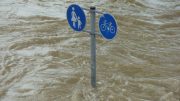Whether it’s called ‘high-tide’ flooding, ‘sunny day,’ or ‘nuisance’ flooding, the problem is getting worse in many coastal communities.
High-tide flooding – sometimes referred to as sunny day or nuisance flooding – is the official term NOAA uses to describe shoreline flooding that is not the result of a storm or some other weather event.
“Sea-level rise flooding is what it is,” says Billy Sweet, a NOAA oceanographer considered the guru of high-tide flooding. “It’s front and center.”
As the warming climate melts glaciers and polar ice, sea levels are rising at rates even experts are having a hard time predicting. Tides are running generally higher as a result, and high-tide flooding is happening more and more. Seawater regularly invades low-lying cities like Miami and Charleston, South Carolina, and bubbles up through shoreline storm drains during full and new moon cycles when tides are even higher.
Weather events from hurricanes to heavy rains and climate phenomena such as El Niño can make the situation worse.
“If the average tide is higher – you will get more flooding,” says Robert Kopp, director of the Rutgers University Institute of Earth, Ocean and Atmospheric Sciences.
Coastal development and subsidence add to the problem
“Flooding really is a human problem; it’s not really a natural problem,” Sweet says. “If a marsh floods is that really a problem? Not really.”
But a flood in a heavily developed coastal area generally wreaks havoc. Making matters worse, shoreline land in some areas is sinking, a phenomenon called subsidence. Some of it is natural – the land still reacting to the weight of the thick ice sheets from the last ice age that ended about 16,000 years ago.
There’s also man-made subsidence caused by the removal of groundwater, oil, gas and other resources. The ground literally compacts into the pockets where those materials once were.
The Atlantic and Gulf coasts are hotspots for sea-level rise
In the U.S., high-tide flooding is mostly on the Atlantic and Gulf coasts. It’s mainly a matter of the offshore topography. The Atlantic and Gulf have shallow, wide coastal plains, so as sea level rises, the water can run up more easily and onto the shoreline.
The West coast has a narrow, deep continental shelf, which keeps sea-level rise increases lower than those on the East coast, especially the Northeast and Mid-Atlantic. It also makes West coast tidal changes less pronounced.
High-tide flooding is growing more common
NOAA has documented high-tide flooding annually since 2014 from 98 tide gauges along all shorelines. The most recent data for the meteorological year from May 2018 through April 2019 reveal that 42 locations are showing “accelerating high-tide flooding trends,” and 25 show a linear increase. Flooding broke records at 12 locations.
Boston had 19 days of flooding, a more than 200% increase from 2000. Maryland broke or tied a number of records: Baltimore and Annapolis each broke records with 12 days and Cambridge had seven. Washington, D.C., had a record 22 days of flooding. Lewisetta, Virgina, also set a record with 15 days, and Windmill Point, Virginia, tied the record of 10 days. Wilmington, North Carolina, broke a record with 14 days, as did Apalachicola, Florida, with 10.
From May 2019 to April 2020, the prediction is that high-tide flooding will occur about twice as often as it did in 2000. Looking further out to 2030 and 2050, some locations including around Chesapeake Bay could flood as many as 175 days a year. Galveston could flood 215 days.
Sea-level rise has consequences
The obvious impact of high-tide flooding is impassable streets, frequently flooded homes and businesses, the potential for permanent damage and unlivable areas and the escalating expense of dealing with these developments – not to mention the physical and psychological disruption to everyday life and outright safety risk. Property values are already declining in the most-affected locations.
Saltwater can contaminate drinking water sources and farm fields as well as corrode infrastructure, leaving mold, rust and decay.
Such flooding also could perpetually wash pollutants of all sorts into the sea – from items such as dangerous chemicals or simple household cleaners stored in flooded areas to overflows from sewers.
Ecosystem and habitat changes due to repeated flooding and just all that additional warm water could also have a cascade of profound impacts on wild animals and plants. Certain species may not be able to survive. If it is a feedstock, the animal that eats it may not survive. If it’s a predator, the animal or plant it’s eating may overpopulate and cause problems that way.
For fish and shellfish in particular, the additional warming water is already pushing stocks elsewhere, disrupting commercial fishing operations up and down the coasts. Entire ecosystems stand to be upended.
Communities can adapt, but retreat may become necessary
There are temporary fixes but no real solutions.
Even if you try to accommodate flooding with things like infrastructure hardening, berms, flood proofing, building elevation, creating spaces that can be inundated, even floating cities, “These are all short-term solutions,” Kopp says. “At some point high-tide flooding will turn into permanent flooding. Then it’s a matter of do you want to live with your house elevated above the water permanently?”
If you can even get to it.
Astrid Caldas, a senior climate scientist with the Union of Concerned Scientists, is blunt. “You cannot adapt your way out of it forever. There are limits to adaptation to sea-level rise,” she says. “It gets to a point where it becomes unmanageable.”
She says the best solution is to reduce greenhouse gas emissions. After that – move away from the shore – retreat. “A word nobody likes,” she says.
And NOAA’s Sweet warns that it’s not an end-of-the-century problem. It’s a problem now. “If water is bubbling up through your streets you’ve waited too long,” he says. “You’re going to get chronic water quickly.”
And based on his newest data, he says: “It’s likely to become chronic sooner [rather] than later.”
August 6, 2019
This article is originally published by Yale Climate Connections





